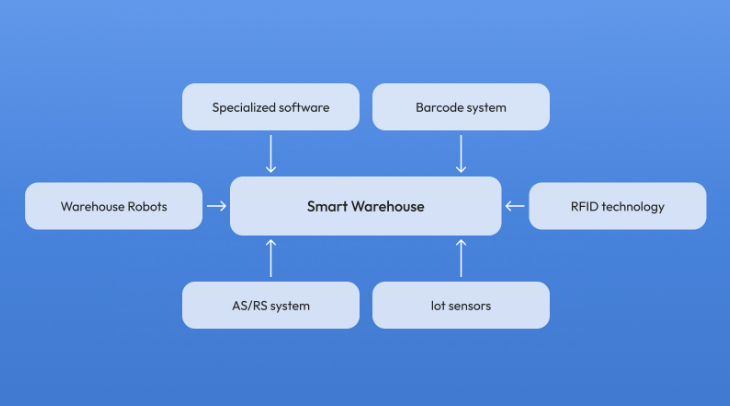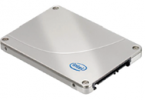With the rise of e-commerce and high demands for super-speed delivery, businesses must move up to more innovative and automated solutions. Top-notch technologies, from the Internet of Things (IoT) through artificial intelligence (AI) and robotics to data analytics, ensure an intelligent warehouse. Now, it appears as a cortex of pretty demanding supply chains where the most important aspect is swiftness, scalability and adaptability.
In this post, we’ll discuss the essence of the smart warehouse, the most prominent innovations in this field, its future tendencies, and how to implement this technology within your business ecosystem.

What Is a Smart Warehouse and is it Effective?
A smart warehouse is a facility that automates operations by leveraging advanced technologies such as AMRs, RFID tags, and an advanced warehouse management system. This approach is way more productive, as it enables businesses to increase productivity and, at the same time, minimize human error count.
Real-time data collection and analytics drive decision-making that is timely and centric on data. It enables warehouse managers to alter quickly in alignment with ever-changing demand and predictively manage disruptions. It allows for operational effectiveness, inventory accuracy optimization, and overall performance maximization of a warehouse.
Besides, a significant percentage cuts down the time and costs for most repetitive tasks, and also reshaping the logistics sector from the hands of labor work to those of human resources engaged in managerial functions and customer service.
Ultimately, integrating such advanced warehouse solutions into daily operations transforms conventional warehouses into dynamic hubs capable of meeting the intricate demands of contemporary business landscapes. It is a perfect mix of speed, accuracy, and innovation that sets a new standard for productivity in logistics.

The 8 Greatest Innovations Powering Modern Warehousing
Today, the field of how the operations in a warehouse are conducted has been experiencing an evolving nature due to advanced technologies. Here is a look at the top 8 advanced technologies that have been shaping the warehousing sector:
- Warehouse Management Systems (WMS). A centralized system orchestrating all warehouse operations through often cloud-based infrastructure for accessing and managing data in real-time.
- Automated Guided Vehicles (AGVs). Robotic vehicles that independently navigate from one location to another, effectively moving goods around the warehouse while reducing human labor and thereby increasing operational efficiency
- Internet of Things (IoT). The interconnection of different devices and systems in a warehouse helps improve traceability, monitorization, and data-analytic processes
- Automated Inventory Control Systems. These systems automate stocktaking and ensure high accuracy and speed in managing inventories, thus at the same time avoiding inaccuracy
- ASRS (Automated Storage and Retrieval Systems). The computer-managed utilization of warehouse space for handling exact and efficient storage and retrieval of items
- Collaborative Robots (Cobots). It is designed to collage with human employees, and they take over repetitive jobs for increased productivity and eliminates labor costs
- Radio-frequency Identification (RFID). The technology enables fast and accurate product tracking, hence real-time visibility and reduction of human intervention
- Mobile Robots. These very versatile robots are deployed in many warehouse functions, from picking and sorting to building operational flexibility and responsiveness
Future Trends in Smart Warehouse Management
Smart warehouses have an enormous advantage because of tech solutions that are inserted in them, like the IoT, ML, and AI. This supports continuous monitoring and analyzing of the data for an optimal layout of the warehouse and its operations. In addition, being tied in accordance with collaborative and mobile robots improves overall efficiency throughout the warehouse.
Here are key tendencies in smart warehouse management systems implementation:
- More accurate inventory management
- Streamlined operational efficiencies
- Decrease in labor cost
- Real-time visibility is improved
- Optimizing the use of space in the warehouse
Implementing Smart Warehousing: Practical Insights
Utilizing smart warehouse systems has been a significant advantage to the industry. Such systems, often developed in conjunction with ERP software development, are equipped with modern technologies and have now become a necessity for companies pursuing efficiency and accuracy increases.
Transitioning to a smart warehouse system involves the deployment of the following set of inter-connected technologies:
- Sensors and RFID Tags Deployment. Required to track products throughout the warehouse, thus guaranteeing an unbroken visibility line and precise inventory management
- Integration of Barcode Scanners. Allows for instant data capture and input, making inventory control more efficient
- Use of Mobile Robots. Such automated assistants can carry things and perform other repetitive functions, enabling a human to reduce manual efforts and work speed
Throughout the implementation process, warehouse managers analyze the existing layout and modify it for maximum efficiency. The flexibility in innovative warehouse solutions allows the tweaking of processes and space utilization.
There are also pretty substantial outcomes:
- Reduced Labor Costs. Achieved notably through automation of routine tasks
- Operational Efficiency. Significantly improved due to the decrease in workflows to simple processes and the reduction of required human intervention
Conclusion
Intelligent warehouses are revolutionizing logistics by leveraging cutting-edge technologies like artificial intelligence and real-time analytics. These innovations are transforming efficiency and automating tasks that were previously manual. For instance, radio-frequency identification (RFID) ensures real-time tracking of every detail of an item, while IoT sensors provide precise and accurate inventories. Collaborative robots now handle repetitive tasks, minimizing human intervention and optimizing space and inventory management. These advancements reduce the effort required by employees, enhance security through automated controls and video surveillance, and offer substantial asset protection.
Additionally, AI and analytics provide predictive insights from historical data, enabling warehouse managers to take a proactive approach toward optimized inventory levels and preemptive solutions to potential operational challenges. This ensures maximum customer satisfaction by fulfilling orders accurately and promptly with minimal errors and high service reliability. In essence, intelligent warehouse systems are transforming traditional logistics frameworks into scalable, secure models, providing a competitive edge in today’s dynamic global marketplace.





Leave a Comment